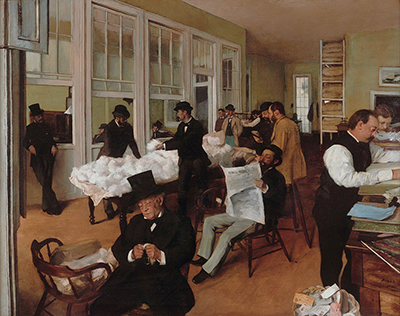The painting is a significant oil on canvas piece as it showcases a part of the artist's trip from Paris to New Orleans in 1873.
The artist had travelled to visit his uncle Michel Musson's cottage factory in New Orleans. He was accompanied alongside by his two brothers. As the artist's trip back home became delayed, he was asked by his family to paint the office in which cotton was sold. This was an immensely significant painting for Degas to create, as it was the first of his pieces that a museum had purchased. Degas felt an immense sense of pride, and finally felt like an established artist that could succeed. The artist's uncle is depicted within the painting near the front examining a piece of cotton. He is dressed in a carbon black suit, paired with a white undershirt. His uncle wears a grand top hat on his head, alongside glasses. He carefully tilts his head to the side as he examines a piece of cotton in his hand from a large bag placed in a chair.
Behind his uncle, his brother Rene is seated reading a newspaper. He gently leans back into his chair as he analyzes the paper in his hand. Rather than being dressed in a full black suit, he wears a light blue pair of pants. The artist's other brother is also present as he stands to the window near the left side of the painting. He is dressed in a fully black outfit as it is difficult to see any of his details. The piece is filled with numerous different figures gently at their job. Two men are seen near the right of the piece looking at paperwork. An endless other number of men stand near the centre of the room sorting through cotton and discussing business. The interesting aspect to note through the piece is the perspective of the painting. Degas is known for his off-centre painting, and this piece indeed holds the same feel. The viewer is placed in the corner of the room, looking at the rest of the people. It's also evident that the viewer is next to the windows as light hits the individuals in the room.
Degas gently creates the piece slightly higher than usual in the perspective of the onlooker. This gives him a chance to truly capture everything in the room. The artist veers away from using any hard colours, and instead sticks to a neutral colour pallet. The only captivating shades he uses throughout the piece is a deep black colour to illustrate the suits of the men. This strategy enables Degas to not use immense detail as it cannot be seen. The gentle green walls add a tad of colour to the piece. Alongside, the warm brown floor gives contrast to the black and white shades filling the canvas. It's interesting to note the grand windows near the left side of the room. They're used to divide the office space into separate cabinets for the owners. Degas initially created the piece as he hoped to sell it to an advertising cotton company to bring business to his uncle. However, with the difficulty of the economy after the war, Degas was unable to do as planned. Yet, as the piece is the first Degas ever sold to a museum, it's a significant piece as it signifies the artistÕs success. This is one of the first impressionism pieces that were purchased and displayed for the public to see. This greatly distinguished itself from the classic realist pieces most commonly seen at the time.




